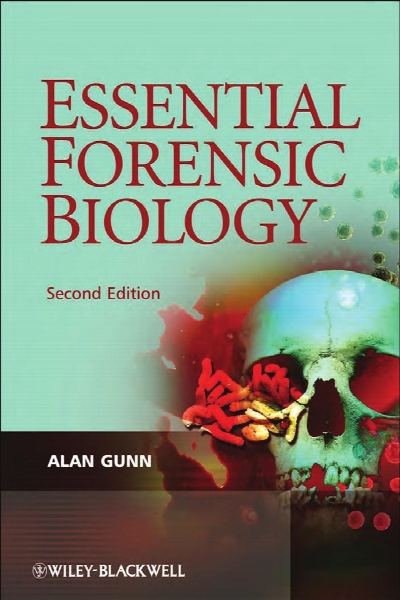Essential forensic biology
- نوع فایل : کتاب
- زبان : انگلیسی
- مؤلف : Alan Gunn
- ناشر : Chichester, UK ; Hoboken, NJ : Wiley-Blackwell
- چاپ و سال / کشور: 2009
- شابک / ISBN : 9780470758045
Description
Acknowledgments -- Introduction -- Part A: Human Remains: Decay, DNA, Tissues And Fluids -- 1: Decay, discovery, and recovery of human bodies -- Dead body -- Stages of decomposition -- Factors affecting the speed of decay -- Discovery and recovery of human remains -- Determining the age and provenance of skeletonized remains -- Future developments -- 2: Body fluids and waste products -- Blood cells and blood typing -- Methods for detecting blood -- Confirming the presence of blood -- Bloodstain pattern analysis -- Artificial blood -- Post mortem toxicological analysis of blood -- Saliva and semen -- Vitreous humor -- Faeces and urine as forensic indicators -- Future directions -- 3: Molecular biology -- Structure of DNA -- DNA sampling -- DNA profiling -- Polymerase chain reaction -- Short tandem repeat markers -- Single nucleotide polymorphism markers -- Determination of ethnicity -- Determination of physical appearance -- Determination of personality traits -- Mobile element insertion polymorphisms -- Mitochondrial DNA -- RNA -- DNA databases -- Future developments -- 4: Human tissues -- Outer body surface -- Hair -- Bones -- Teeth -- Future developments -- 5: Wounds -- Definitions -- Blunt force injuries -- Sharp force traumas -- Bone damage -- Additional aspects of wound interpretation -- Asphyxia -- Pathology associated with drug use -- Gunshot wounds -- Bite marks -- Burns and scalds -- Ageing of wounds -- Post mortem injuries -- Future developments -- Part B: Invertebrates And Vertebrates -- 6: Invertebrates 1: Biological aspects -- Introduction to invertebrate biology -- Invertebrates as forensic indicators in cases of murder or suspicious death -- Invertebrates as a cause of death -- Invertebrates as forensic indicators in cases of neglect and animal welfare -- Role of invertebrates in food spoilage and hygiene litigation -- Illegal trade in invertebrates -- Invertebrate identification techniques -- Future directions -- 7: Invertebrates 2: Practical aspects -- Calculating the PMI/time since infestation from invertebrate development rates -- Complicating factors affecting earliest oviposition date calculations -- Determination of the PMI using invertebrate species composition -- Determination of the PMI using ectoparasites -- Determination of movement from invertebrate evidence -- Invertebrate evidence in cases of wound myiasis and neglect -- Detection of drugs, toxins and other chemicals in invertebrates -- Obtaining human/vertebrate DNA evidence from invertebrates -- Determining the source and duration of invertebrate infestations of food products -- Collecting invertebrates for forensic analysis -- Killing and preserving techniques for invertebrates -- Future directions -- 8: Vertebrates -- Introduction -- Vertebrate scavenging of human corpses -- Vertebrates causing death and injury -- Neglect and abuse of vertebrates -- Vertebrates and drugs -- Vertebrates and food hygiene -- Illegal trade and killing of protected species of vertebrates -- Identification of vertebrates -- Future directions -- Part C: Protists, Fungi, Plants And Microbes -- 9: Protists, fungi, and plants -- Introduction -- Portists -- Fungi -- Plants -- Plant secondary metabolities as sources of drugs and poisons -- Illegal trade in protected plant species -- Future directions -- 10: Bacteria and viruses -- Introduction -- Role of microorganisms in the decomposition process -- Microbial profiles as identification tools -- Microbial infections and human behaviour -- Microbial infections that can be mistaken for signs of criminal activity -- Use of microorganisms in bioterrorism -- Future directions -- References -- Index.
From the Publisher: This book is an introduction to the application of biology in legal investigations. Fully revised and updated throughout, the second edition of this highly successful textbook offers an accessible overview to the essentials of the subject providing a balanced coverage of the range of organisms used as evidence in forensic investigations; invertebrates, vertebrates, plants and microbes. The book provides an overview of the decay process and discusses the role of forensic indicators-human fluids and tissues, including blood cells, bloodstain pattern analysis, hair, teeth, bones, and wounds. It also examines the study of forensic biology in cases of suspicious death. The coverage of molecular techniques has been expanded throughout with additional material on bioterrorism and wildlife forensics now included. The use of DNA and RNA for the identification of individuals and their personal characteristics is now covered along with a discussion of the ethical issues associated with the maintenance of DNA databases. Fully revised and updated new edition of this highly successful textbook. Includes self-assessment questions at the end of each chapter and case studies. Now in full colour throughout. Includes a supplementary website (www.wileyeurope.com/college/gunn) covering additional material and self-test questions to reinforce student understanding. Read less


